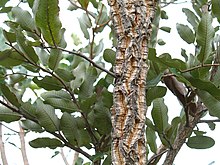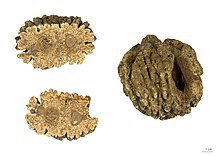| Parinari | |
|---|---|

| |
| Parinari curatellifolia | |
| Scientific classification | |
| Kingdom: | Plantae |
| Clade: | Tracheophytes |
| Clade: | Angiosperms |
| Clade: | Eudicots |
| Clade: | Rosids |
| Order: | Malpighiales |
| Family: | Chrysobalanaceae |
| Genus: | Parinari Aubl.[1] |
| Species | |
|
See text | |
| Synonyms | |
| |

Parinari is a genus of plant in the family Chrysobalanaceae.[2]
Species of genus Parinari are found in Subsaharan Africa from Senegal to Sudan and Kenya and south to Namibia and Natal; in Eastern Madagascar; from Indochina through Indonesia, New Guinea, northern Queensland, and the southwest Pacific; and in Central and South America from Costa Rica to Trinidad and southern Brazil.[1][2] The oldest fossils of Parinari fruits are from the early Miocene of Ethiopia, Panama, and Colombia.[2]
The genus is closely related to Neocarya.[3]
Parinari can be distinguished from other genera in Chrysobalanaceae by the following characteristics:[4]
- zygomorphic floral symmetry
- 6-10 unilaterally-attached stamens per flower
- ovary at side or mouth of receptacle-tube
- leaf lower surface lanate and with hair-filled stomatal cavities and parallel secondaries closely spaced
- pair of glands on leaf petiole
- large, woody fruits
- ^ a b Cite error: The named reference
Kewwas invoked but never defined (see the help page). - ^ a b c Cite error: The named reference
Judwas invoked but never defined (see the help page). - ^ Chave, Jérôme; Prance, Ghillean T.; Sothers, Cynthia A.; Dexter, Kyle G.; Chamagne, Juliette; Bardon, Léa (2013-01-01). "Origin and evolution of Chrysobalanaceae: insights into the evolution of plants in the Neotropics". Botanical Journal of the Linnean Society. 171 (1): 19–37. doi:10.1111/j.1095-8339.2012.01289.x. ISSN 0024-4074.
- ^ Prance, G.T.; Sothers, C. (2009). "Neotropical Chrysobalanaceae". In Milliken, W.; Klitgård, B.; Baracat, A. (eds.). Neotropikey - Interactive key and information resources for flowering plants of the Neotropics. Royal Botanic Gardens, Kew. Retrieved 2019-09-17.